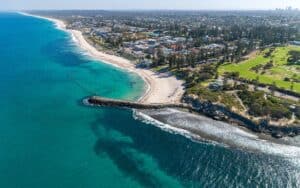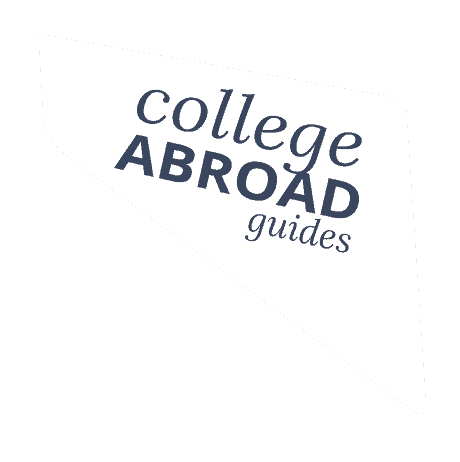
G’Day Uni: How to Go to College in Australia

- Originally published
- Last updated on November 11th, 2023 at 09:21 pm
Table of Contents
The 101 Guide to Going to College in Australia (for International Students)
Almost 4,200 American students are going to college (that’s “university” in Australia), and more than that are studying abroad for international experience down under as part of an American degree program.
That’s a lot of Americans on Australian campuses. It’s surprising because Australia has a small population, with just 26 million residents spread across 3 million square miles. But it’s also understandable. After all, Australia is a large, developed, English-speaking democracy that looms as large as its land area in the American imagination.
Think Crocodile Dundee. Steve Irwin. The Wiggles.
Australia is winning popularity contests (we’re pretty sure it’s because of the Wiggles). In fact, the number of international students has increased 26% year over year.
Want to go waltzing with Mathilda? Let’s break down the basics of going to college in Australia.
Can I go to college in Australia?
Yes, Americans can go to college in Australia. It’s a little more difficult than many countries since Australia has multiple ways to apply. If your high school allows you to get an international baccalaureate (IB) diploma, and you’re interested in schools in New South Wales or the Australian Capital Territory, apply through the application portal, UAC, where your application goes to multiple universities simultaneously. If your school isn’t IB, apply directly to each school you’re interested in.
There is one bonus, however. Applying separately means there are no limits to the number of programs you apply to.
But the process can be cumbersome. Luckily, admissions applications are largely online. You’ll pay application fees of $50-$150 for every school you apply for.
Most programs are 3 years long, from liberal arts to history, English, business, music, and math. Other programs are longer:
-
- Social work: 4 years
-
- Engineering: 4 years
-
- Dentistry: 5 years (undergrad)
-
- Medicine: 6 years (undergrad)
Like the U.K., prospective students in Australia should look at the available courses (read: majors) they want to study and apply to the program, not the university as a whole. They’ll be offered admission to a particular program. That means that students can’t change their course of study easily. They’ll have to apply to the university again, likely without any classes transferring to their new preference.
Can I transfer to a university in Australia?
Students looking to join specialized programs will likely find they haven’t completed the coursework in their programs to warrant earning transfer credit. If you’re transferring from within Australia, you may get transfer credits on a case-by-case basis. However, students from other programs or countries have it harder.
Commonly, transferring is not possible from outside a comparable Australian program. However, there are a couple of ways Australian universities may recognize your international experience:
-
- A department head or dean may recognize your coursework. If you can’t get credit, you may qualify to skip lower-level prerequisites.
-
- If your current university has a reciprocal relationship with the Australian university you want to apply to, the department may recognize your previous classes. There are hundreds of these partnerships, many for research purposes. But there are also a lot of partnerships for study-abroad students. That might mean your university recognizes classes you’ve taken before as part of a degree you’re interested in pursuing. It’s worth asking.
Is Australia good for international students?
Benefits of Studying in Australia
Australia is an international hub for degree-seeking undergrads. There are lots of reasons why.
-
- Its 2000 Education Services for Overseas Students Act (ESOS) provides a legal framework that protects international students. It lays out the services they must receive by law, protecting the quality of education you get in Australia.
-
- ESOS includes a provision for orientation and student services to help you adjust to Australian life.
-
- The government’s “Destination Australia” program provides scholarship money to encourage international students to enroll.
-
- Australia’s job market is “red hot.” That’s a bonus for students with local experience and degrees.
-
- Australia has a high quality of life. It’s a developed commonwealth country with a laid-back attitude, enough slang to make it feel like you’ve got a whole new language to learn, and thousands of miles of gorgeous scenery.
-
- You’ve got plenty of company. Nearly half of all students come from abroad at the universities of Melbourne and Sydney. Australia is #1 globally for the percentage of international students at its universities—26.7% in 2019.
-
- Your degree will come with high academic standards. The University of Melbourne, Monash University, University of Queensland, University of Sydney, Australian National University, and UNSW Sydney all rank in the world’s top 100.
-
- There are robust scholarship and funding opportunities for international students.
Drawbacks of Studying in Australia
Studying in Australia isn’t always as sunny as a December afternoon in the outback. Here are some pain points:
-
- Tuition costs. It’ll set you back $150 just to apply to the University of Sydney (That’s $100 in U.S. dollars). Then you’ll pay $45,000-$49,000 a year. Plus extra fees. Ouch.
-
- After you pay tuition, the cost of living index is high, ranking 8th in the world.
-
- International students hesitate to return post-COVID. Australia’s stringent COVID lockdowns kept international students from their educations for a long period of time. Even by December, 2021, more than half of Australia’s international students were unable to enter the country. Students are coming back, but are more focused on prestigious universities now.
Can international students work in Australia?
You can work with a student visa in Australia. Students can work 48 hours every 2 weeks while school’s in session. They can work unlimited hours during holidays. Student workers need to keep up attendance and satisfactory progress toward their degrees.
In Australia, volunteering does not count toward these hours.
Australia caps international migration, so not every international student will be able to stay in Australia permanently. You can apply for a “skilled graduate” visa after attending 2 years at an Australian university. The visa allows grads to stay in Australia for 18 months.
There’s a “temporary graduate work visa” that the government extends to grads of 400 educational programs in Australia. It lets new workers with a qualifying undergraduate degree stay in Australia for 4 years.
How many universities can you apply to in Australia?
There’s no limit to how many Australian undergraduate programs or universities ou can apply to. Because there’s no central portal for all of Australia, apply to your chosen programs individually. Be sure that you understand the different requirements and pay individual fees for each.
How many universities are in Australia?
Australia boasts 43 universities to serve almost a million international students. Most are in the populous eastern half of the nation, clustered around the major hubs of Victoria, New South Wales, and Queensland. For example, in the sparsely populated Northern Territory, you’ll find only Charles Darwin University. In Tasmania, there’s only the University of Tasmania. Most are also public—just three private schools are among Australia’s universities. These are the three private universities:
-
- Bond University
-
- University of Notre Dame Australia
-
- Torrens University of Australia
That’s not to say private schools are inferior or uncommon in Australia. Top private schools include
-
- Carnegie Mellon University
-
- University of Divinity
-
- Avondale University
Private universities are fairly new. It wasn’t until 1987 that Australia’s first private university, Bond University, made the scene. And international students have barely had time to make their mark on South Australia’s Torrens University, with a campus that dates from 2014.
The Group of Eight
Australia’s Ivy League, the Group of Eight, are considered the most prestigious and research-friendly universities in the country. They include:
-
- University of Melbourne
-
- University of Adelaide
-
- Australian National University
-
- University of Sydney
-
- University of Western Australia
-
- University of Queensland
-
- Monash University
-
- University of New South Wales
The Group of Eight are highly internationalized, with strong contingencies of international students. They also have more partnerships with international universities aroudn the world.
How much is going to college in Australia?
College in Australia can be extremely expensive for international students. Because every penny counts, here are the application portals for colleges in Australia that don’t charge an application fee (usually this privilege is for direct applications submitted to the college online only).
-
- RMIT (Some countries pay a $100 Australian fee)
-
- Bond University (Queensland)
-
- University of Victoria (some scholarship applicants only, otherwise applying costs $75 Australian)
Is university free in Australia?
No, university is not free in Australia for citizens nor international students. Tuition fees started in 1989, when many more Australians were attending universities than before. However, Australians still benefit from a “free at the point of entry” scheme including government subsidies and loans. This system has made it possible that more promising students can access college than if colleges demanded tuition upfront. Graduates pay back loans based on income, with unemployed and part-time earners avoiding loan repayment altogether.
However, the system has also meant many Australians struggle to pay back loans (one in five students will not repay these loans). Australians who work and pay taxes abroad aren’t subject to repayment enforcement, either. Ten percent of borrowers will live and work abroad, avoiding loan payments.
International students must pay tuition and fees, as well as cover their living costs.
Can I use financial aid to go to college in Australia?
Students can use U.S. financial aid at 34 major Australian universities. That includes all the universities ranked in the world’s top 200.
When does university start in Australia?
Welcome to the land down under. In Australia, fall term starts between the last week in February and the first week in March. Students enjoy a mid-term break of a week in April and final teaching days occur between late May and late June, depending on the university. Exam periods can end mid-June through the first days of July.
After a month break, spring session starts in July., with exams typically ending mid-November. There are a few outlying universities, so check your own program. However, most operate on a semester schedule. There are summer session courses available in December, January, and February.
How to apply to colleges in Australia
Applying to college in Australia means paying attention to the individual requirements of each program you’re interested in. Use the student portals online for your university. You’ll need to provide transcripts, test scores, and recommendations, but also passport and citizenship information.
Related Posts

Jessica Share
Jessica is the writer, Ph.D., and mom-of-an-abroad-student-in-the-UK at the helm of College Abroad Guides. When she's not asking college students where the coolest place to hang out in their city is, she's figuring out how she can make $60 imported Greek oregano potato chips and £50 British bacon potato chips appear on her doorstep for the cost of a local bag of Lay's.






























